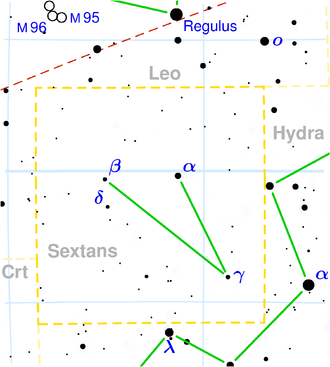NGC 3169
| Galaxy NGC 3169 |
|
|---|---|

|
|
| HST image of NGC 3169 | |
| AladinLite | |
| Constellation | sextant |
|
Position equinox : J2000.0 , epoch : J2000.0 |
|
| Right ascension | 10 h 14 m 15.0502 s |
| declination | + 03 ° 27 ′ 57.875 ″ |
| Appearance | |
| Morphological type | SA (s) a / HII / LINER |
| Brightness (visual) | 10.3 mag |
| Brightness (B-band) | 11.2 mag |
| Angular expansion | 4.2 ′ × 2.9 ′ |
| Position angle | 45 ° |
| Surface brightness | 12.9 mag / arcmin² |
| Physical data | |
| Affiliation | NGC 3166 group LGG 192 |
| Redshift | 0.004130 ± 0.000013 |
| Radial velocity | 1238 ± 4 km / s |
|
Stroke distance v rad / H 0 |
(49 ± 4) · 10 6 ly (15.1 ± 1.1) Mpc |
| history | |
| discovery | Wilhelm Herschel |
| Discovery date | December 19, 1783 |
| Catalog names | |
| NGC 3169 • UGC 5525 • PGC 29855 • CGCG 036-066 • MCG + 01-26-26 • IRAS 10116 + 0342 • 2MASX J10141509 + 0327580 • GC 2041 • H I 4 • h 685 • HIPASS J1014 + 03 • LDCE 715 NED003 • NVSS J101415 + 032757 • WISEA J101415.05 + 032757.8 • HOLM 173B • KPG 228B | |
NGC 3169 is a spiral galaxy with an active nucleus of the Hubble type Sa with extensive star formation regions in the constellation Sextant south of the ecliptic . It is estimated to be 49 million light years from the Milky Way and about 70,000 light years in diameter. Together with NGC 3165 and NGC 3166 it forms the gravitationally bound galaxy trio Holm 173 or KPG 228 and is the brightest galaxy of the NGC 3169 group ( LGG 192 ).
The galaxies NGC 3156 and NGC 3165 are located in the same area of the sky .
The supernovae SN 1984E (Type IIL) and SN 2003cg ( Type Ia ) were observed here.
The object was discovered by Wilhelm Herschel on December 19, 1783 .
NGC 3169 group ( LGG 192 )
| Galaxy | Alternative name | Distance / million ly |
|---|---|---|
| NGC 3156 | PGC 29730 | 53 |
| NGC 3165 | PGC 29798 | 54 |
| NGC 3166 | PGC 29814 | 54 |
| NGC 3169 | PGC 29855 | 49 |
| PGC 29969 | UGC 5539 | 51 |
Web links
- SIMBAD Astronomical Database
- ESO : A Disheveled Pair of Galaxies + Photos, Map & Animation - April 20, 2011
- astronews.com: Picture of the day July 24, 2019
- Aladin Lite
